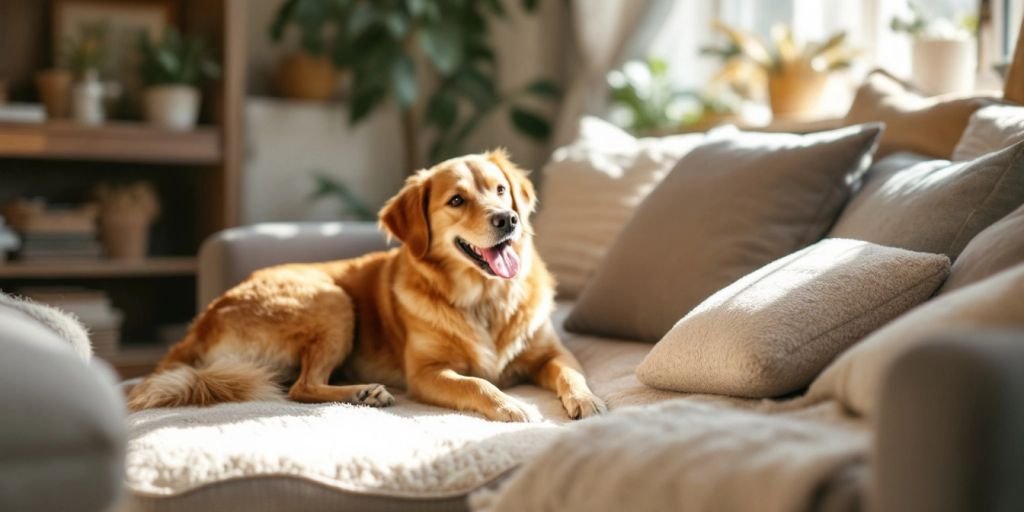
Adapting your home for dogs with arthritis is essential for their comfort and mobility. By making simple changes, you can significantly enhance their quality of life. This guide will provide practical tips on how to create a supportive environment for your furry friend.
Key Takeaways
- Choose an orthopedic bed for better joint support.
- Use non-slip mats to prevent slipping on floors.
- Install ramps or stairs for easy access to furniture.
- Elevate food and water bowls to reduce strain on their necks.
- Maintain clear outdoor paths for safe movement.
Creating a Comfortable Living Space
Making your home cozy for a dog with arthritis is essential for their comfort and mobility. Here are some ways to create a supportive environment:
Choosing the Right Dog Bed
A good bed is vital for arthritic dogs to ease pressure on their joints. Look for an orthopedic bed that offers proper support. Memory foam beds are excellent because they adjust to your dog’s shape, providing comfort. Ensure the bed is the right size so your dog can lie down and stretch without feeling cramped. A heated bed can also help relieve pain and stiffness.
Flooring and Traction
Dogs with arthritis often struggle on slippery floors. To help prevent accidents, consider using rugs or non-slip mats in areas where your dog spends time, like the kitchen or living room. If your dog enjoys the outdoors, ensure the ground is safe and not too hard or slippery. Keeping your yard clear of obstacles is also important for their safety.
Accessibility and Mobility
Arthritic dogs may find it hard to reach places they used to access easily. Use ramps or stairs to help them get to furniture or cars, reducing strain on their joints. Make sure their food and water bowls are at a comfortable height. Elevated bowls can lessen the strain on their neck and back. If mobility is a concern, consider options like physical therapy or acupuncture to improve their joint function.
Creating a safe and comfortable space for your dog is a loving act that can greatly enhance their quality of life.
By making these adjustments, you’re ensuring that your pet’s living space is not only safe but also accommodating and comfortable. Each change represents a step towards providing them with a loving and fitting home.
Key Recommendations for Supplies
- Orthopedic beds for comfort
- Non-slip mats for safety
- Ramps for easy access
- Elevated bowls to reduce strain
- Heated beds for warmth
These simple changes can make a big difference in your dog’s daily life, helping them feel more at ease in their home.
Managing Your Dog’s Weight and Diet

Importance of a Balanced Diet
A balanced diet is crucial for dogs with arthritis. Consult your veterinarian to ensure your dog gets the right nutrients. A diet rich in omega-3 fatty acids can help reduce inflammation and pain. Pay attention to the ingredients in your dog’s food; avoid fillers that can lead to weight gain. Consider switching to high-quality, grain-free dog food designed for weight management.
Weight Management Tips
Here are some tips to help manage your dog’s weight:
- Measure your dog’s food to avoid overfeeding.
- Incorporate healthy snacks like baby carrots or apple slices.
- Monitor your dog’s weight regularly to catch any gain early.
Supplements for Joint Health
Supplements can be beneficial for arthritic dogs. Speak with your veterinarian about:
- Glucosamine and chondroitin to lubricate joints.
- Natural remedies like turmeric for its anti-inflammatory properties.
- CBD oil, which is gaining popularity for arthritis treatment.
Keeping your dog at a healthy weight is essential to prevent further joint issues. Regular check-ups with your vet can help ensure your dog stays on track with their health.
By managing your dog’s weight and diet, you can significantly improve their quality of life and help them cope with arthritis more effectively. Remember, early intervention is key to maintaining their health and comfort.
Adapting Your Home’s Flooring
Covering Slippery Floors
Many homes have hard surfaces like wood or tile, which can be slippery for dogs, especially those with arthritis. Preventing slips is crucial to keep your dog safe. Here are some ways to cover slippery floors:
- Use non-slip mats in high-traffic areas.
- Consider area rugs with a non-slip backing.
- Apply anti-slip tape on slippery surfaces.
Using Rugs and Mats
Rugs and mats can provide better traction for your dog. They help reduce the risk of falls and make it easier for your dog to move around. When choosing rugs, look for:
- Thick, plush materials for comfort.
- Non-slip backing to keep them in place.
- Easy-to-clean options to maintain hygiene.
Choosing Dog-Friendly Flooring
If you’re thinking about new flooring, consider options that are easier on your dog’s joints. Some good choices include:
- Vinyl: Soft and easy to clean.
- Cork: Provides cushioning and is non-slip.
- Carpet: Offers warmth and traction.
Making these changes ensures that your home is not only safe but also comfortable for your furry friend. Each adjustment is a step towards creating a loving environment that meets their needs.
By adapting your flooring, you can help your dog navigate their home with more ease and comfort, reducing the risk of injury and enhancing their quality of life. Remember, a few thoughtful changes can make a big difference!
Making Stairs and Steps Accessible
Using Ramps and Stairs
To help your dog with arthritis, ramps and stairs can be a great solution. Ramps are especially helpful for senior dogs or dogs with severe arthritis. You can place ramps near the entrance or exit of the house, so your dog can move around more easily. Here are some tips for using ramps and stairs:
- Ensure ramps are sturdy and have a non-slip surface.
- Use a harness to support your dog when going up or down stairs.
- Consider the angle of the ramp; it should be gentle enough for your dog to navigate comfortably.
Installing Stair Gates
Stair gates can be a simple yet effective way to keep your dog safe. They prevent your dog from attempting to climb stairs when they might not be able to do so safely. Here are some benefits of using stair gates:
- Prevents falls by restricting access to stairs.
- Allows you to control your dog’s movement in the house.
- Can be easily installed and removed as needed.
Carrying Small Dogs Safely
If your dog is small and struggles with stairs, carrying them might be necessary. However, it’s important to do this safely:
- Use both hands to support your dog.
- Keep your back straight to avoid injury.
- Make sure your dog feels secure in your arms.
Making your home accessible for your dog can greatly improve their quality of life. By adapting stairs and steps, you can help them navigate their environment with more ease and comfort.
By implementing these changes, you can create a safer and more comfortable living space for your dog, allowing them to enjoy their home without the fear of injury.
Ensuring Safe Access to Furniture
Making sure your dog can safely access furniture is essential for their comfort and well-being. Simple changes can make a big difference in their daily life. Here are some tips to help your furry friend navigate your home more easily:
Using Ramps for Furniture
- Install ramps to help your dog reach couches or beds without jumping.
- Choose ramps with a gentle slope to make it easier for them to climb.
- Ensure the ramp has a non-slip surface to prevent accidents.
Training Your Dog to Use Steps
- Teach your dog to use steps safely by guiding them with treats.
- Use positive reinforcement to encourage them to go up and down.
- Be patient; it may take time for them to feel comfortable.
Alternatives to Furniture Access
- Consider using dog beds that are low to the ground for easy access.
- Provide cozy spots on the floor with blankets or cushions.
- If your dog struggles with stairs, think about keeping them on one level of the house.
Making these adjustments shows you care about your dog’s comfort and safety. Every little change helps create a loving environment for your special needs pet.
By following these tips, you can ensure that your home is a safe and welcoming space for your dog, especially if they have arthritis or other mobility issues. Remember, your dog’s happiness is worth the effort!
Improving Outdoor Spaces
Maintaining Safe Pathways
To ensure your dog can move around safely outside, it’s important to keep pathways clear and secure. Here are some tips:
- Remove obstacles like rocks or branches that could cause trips.
- Ensure the ground is even and well-maintained to prevent slips.
- Use non-slip surfaces to help your dog feel stable.
Creating Accessible Toileting Areas
Dogs need easy access to their toileting spots. Here’s how to make it easier for them:
- Choose a location that is close to the house.
- Make sure the area is free from hazards like mud or steep slopes.
- Keep the surface non-slip to help your dog feel secure while doing their business.
Using Non-Slip Surfaces Outdoors
Non-slip surfaces are essential for dogs with arthritis. Consider these options:
- Install rubber mats in high-traffic areas.
- Use textured paving stones for better grip.
- Avoid slippery materials like smooth tiles or wood.
Making these adjustments not only helps your dog navigate better but also enhances their overall quality of life. Remember, a safe outdoor space is vital for their happiness and health.
By focusing on these areas, you can create a supportive outdoor environment that caters to your dog’s needs, allowing them to enjoy their time outside without fear of injury. This is especially important as you treasure the memories with your older dog.
Enhancing Your Dog’s Sleeping Area

Choosing the Right Bedding
A good bed is essential for dogs with arthritis. Look for orthopedic beds that provide support and comfort. Memory foam is a great choice because it molds to your dog’s body. Here are some tips for selecting the right bed:
- Ensure the bed is large enough for your dog to stretch out comfortably.
- Consider a heated bed to help ease joint pain.
- Look for beds with removable, washable covers for easy cleaning.
Positioning the Bed
The location of your dog’s bed can greatly affect their comfort. Place the bed in a warm, draft-free area. Avoid high-traffic spots where your dog might be disturbed. Here are some positioning tips:
- Keep the bed away from doorways to minimize disturbances.
- Ensure the bed is on a flat surface to prevent slipping.
- Position it near family areas so your dog feels included.
Ensuring Easy Access to the Bed
Making sure your dog can easily get to their bed is crucial. Avoid any obstacles that could cause them to trip. Here are some ways to ensure easy access:
- Use ramps or low steps if the bed is elevated.
- Keep the area around the bed clear of clutter.
- Train your dog to use the bed safely, encouraging them to jump up gently.
Providing a comfortable sleeping area is vital for your dog’s health and happiness. A well-chosen bed can help alleviate pain and improve their quality of life, especially for those with arthritis. Remember, small changes can make a big difference!
Creating a cozy sleeping space for your dog can make a big difference in their comfort and happiness. Consider adding a soft bed, some blankets, and a favorite toy to make it feel special. For more tips on how to enhance your dog’s life, visit our website!
Conclusion
Making your home friendly for dogs with arthritis is really important. By creating a cozy space, choosing the right bed, and ensuring safe movement, you can help your furry friend feel better. Simple changes like adding ramps, using non-slip mats, and raising food bowls can make a big difference. Remember, your dog may not show pain, but they still need your help. With a little effort, you can improve their comfort and happiness, allowing them to enjoy life more fully.
Frequently Asked Questions
What kind of bed is best for a dog with arthritis?
An orthopedic bed with memory foam is ideal because it supports your dog’s joints and helps them feel comfortable.
How can I make my floors safer for my dog?
You can add rugs or non-slip mats to slippery areas to help your dog walk without slipping.
Should I change my dog’s diet if they have arthritis?
Yes, a balanced diet can help manage your dog’s weight, which is important for their joint health.
What can I do to help my dog go up and down stairs?
Using ramps or installing stair gates can help your dog navigate stairs more safely.
How can I ensure my dog can access furniture safely?
Consider using ramps or small steps to help your dog get on and off furniture without jumping.
What outdoor changes can I make for my dog with arthritis?
Make sure pathways are clear and use non-slip surfaces to help your dog move around safely outside.




